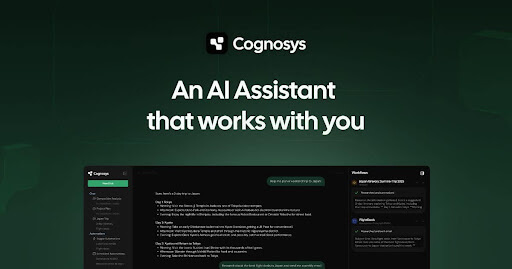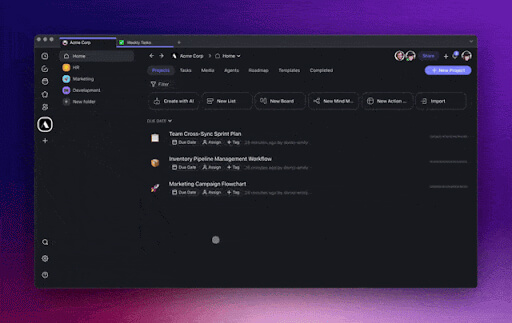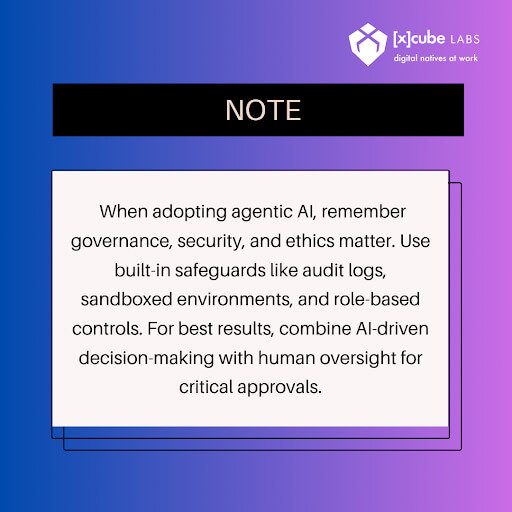 1-800-805-5783
1-800-805-5783 
In just a few short years, we’ve gone from AI that assists to AI that acts. Welcome to the age of Autonomous AI, where intelligent systems no longer wait for commands – they take initiative, learn, adapt, and execute tasks with minimal human input. For enterprises, this evolution opens up a new era of intelligent automation and strategic efficiency.
Agentic AI tools are a new class of AI-driven software that operates with a high degree of autonomy and goal-oriented behavior. Unlike traditional bots or basic AI agents that follow predefined rules, agentic AI tools can decide what needs to be done and how to do it, often coordinating multiple steps and tools to achieve a goal. In other words, an agentic AI tool doesn’t just wait for a prompt and produce an output; it actively plans, executes, and adapts tasks on your behalf.
Imagine having a digital colleague who not only answers your questions but also takes the initiative – scheduling meetings, sorting data overnight, drafting reports, and even brainstorming ideas. That’s the promise of agentic AI. These autonomous agents function more like proactive team members than passive tools. They can set objectives, iterate on failures, and adjust to new information in real-time.
How is this different from traditional automation or simple “AI agents”? Traditional automation (like classic RPA or scripted workflows) is rigid and predefined – great for repetitive tasks but unable to handle surprises or learn from new data. Basic AI agents (like chatbots or recommendation engines) are more flexible but still bounded by a narrow scope – they react to inputs but don’t strategize beyond their programming.

Agentic AI tools, by contrast, combine the reliability of automation with the adaptability of AI-driven decision-making. They perceive context, make informed judgments, and carry out multi-step processes without constant supervision. As one analysis puts it, AI-driven automation doesn’t just follow instructions – it improves them by learning and adjusting in real-time.
For enterprises, the rise of agentic AI tools is a transformative development. It’s not just about doing things faster; it’s about doing the right things more smartly.
These systems can autonomously optimize workflows, uncover insights, and even coordinate other software or AI services. No wonder 48% of enterprises are already piloting agentic AI solutions as of Q1 2025. Businesses are exploring agentic AI to move beyond basic efficiency gains and achieve strategic, autonomous operations.
In an enterprise setting, agentic AI tools act as force multipliers for your workforce. They handle complex, goal-driven tasks that typically require human judgment but at machine speed and scale. Here are a few value-driven reasons they’re generating buzz in 2025:

Importantly, agentic AI isn’t about replacing employees – it’s about augmenting teams with “autonomous co-workers.” By handling the heavy lifting of data processing and routine decisions, these AI agents enable human staff to concentrate on creativity, complex problem-solving, and relationship management. (For a deeper dive into how autonomous agents fit into today’s AI ecosystem, see our explainer on the role of autonomous agents.
With the concept of agentic AI defined, let’s look at some of the best agentic AI tools making waves in 2025. These examples (focused on enterprise-level solutions) illustrate the range of platforms available, from big tech offerings to innovative startups. Each is designed to empower organizations with AI that acts rather than just answers.
1. IBM Watsonx Orchestrate – Autonomous Workflow Orchestration: IBM’s Watsonx Orchestrate is a prime example of an enterprise agentic AI platform. It allows businesses to deploy AI “digital employees” that can connect across apps (email, calendars, CRM, HR systems, etc.) and perform multi-step business processes autonomously. For instance, an Orchestrate agent can assist a hiring manager by screening resumes, scheduling interviews, sending follow-up emails, and updating the HR system—all independently.
The value for enterprises lies in streamlining complex workflows: Watsonx Orchestrate’s agents share information and coordinate tasks, reducing manual work by up to 75% in internal trials. In short, IBM’s tool acts like a smart operations assistant, integrating with 80+ typical business applications to take care of the busy work. It’s built with enterprise governance in mind (security, compliance, audit logs), which is crucial for large organizations adopting agentic AI.
2. Microsoft Semantic Kernel & AutoGen – Agentic Frameworks for Developers: Microsoft has been actively enabling agentic AI through its developer tools. Semantic Kernel is an open-source framework that helps integrate large language models (LLMs) into your business workflows in a secure, controlled way. It’s designed for enterprise applications, emphasizing integration with Microsoft’s ecosystem (such as Teams, Outlook, and Dynamics) and robust governance.
On the other hand, Microsoft AutoGen (from Microsoft Research) is a framework specifically for building multi-agent systems – AI agents that can converse with each other to solve problems. AutoGen gained attention for enabling complex scenarios, such as an “executor” agent that writes and debugs code by collaborating with a “planner” agent.
For enterprises, the takeaway is that Microsoft’s agentic AI tools offer production-grade reliability and deep integration with existing infrastructure. Suppose your development teams want to embed goal-driven AI capabilities into enterprise software (for example, an AI that can take a high-level request and generate working code or a business report). In that case, Microsoft’s Semantic Kernel and AutoGen provide the building blocks to do it with enterprise-level security.
3. OpenAI Functions and AutoGPT – Open-Source Agentic AI Examples: OpenAI’s technology underpins many agentic solutions. In particular, the function-calling capabilities of GPT-4 (and the plugin ecosystem of ChatGPT) enable the AI to trigger actions, such as querying databases, sending emails, or invoking APIs, in response to user goals.
This allows ChatGPT to act as an agent orchestrating other tools. On the community side, projects such as AutoGPT and BabyAGI garnered significant attention in early 2024 as open-source “autonomous AI” experiments. These projects showed how an LLM-based agent could recursively prompt itself, plan tasks, and execute web or file operations toward a goal you give it.

While AutoGPT and similar agents are experimental (and not always reliable without human oversight), they have been pivotal examples of agentic AI tools that sparked enterprise interest. Many companies began prototyping internal solutions using these frameworks to explore how AI might handle tasks such as market research or internal ticket triage autonomously.
The key lesson from the OpenAI ecosystem is that generative AI can be extended into agentic AI with the proper scaffolding. Enterprises leveraging OpenAI (via Azure OpenAI Service or OpenAI’s API) are starting to build agents that combine GPT’s intelligence with action-taking abilities, for example, an AI that not only drafts an email response to a client but also checks CRM records and schedules the next meeting automatically.

4. Cognosys (Autonomous AI Agent Platform) – Startup Spotlight: Cognosys is a relatively new platform that brands itself as an “operating system for autonomous AI agents.” It’s designed to let businesses delegate complex tasks to AI agents that operate over the web and enterprise apps, much like a human would – but faster.

Cognosys agents can break down goals into subtasks, interact with web interfaces or APIs, and adjust their plans based on the results. For example, you could ask Cognosys to “research our top 5 competitors and draft a SWOT analysis.” It will browse websites, gather data, and produce a report without step-by-step instructions. What makes Cognosys stand out is its focus on UI-level automation (it can use browser interfaces without needing special integrations), which means it can work with many cloud apps out of the box.
Enterprise teams experimenting with Cognosys have found it helpful for operations and research tasks that span multiple systems. It’s essentially like hiring a super-fast intern who can use any software tool – the agent logs in, clicks buttons, copies data – to get the job done. As agentic AI startups like Cognosys mature, they’re bringing fresh ideas on how to implement autonomy without waiting for every app to expose an API.
5. No-Code Agent Builders (e.g., Taskade AI, AgentHub) – Democratizing Agentic AI: Not every enterprise has a team of AI engineers ready to build custom agents. That’s where no-code or low-code agentic AI tools come in. Platforms like Taskade (AI Agents) and AgentHub offer visual interfaces for designing and deploying AI-driven workflows.
For instance, Taskade AI Agents allows you to set up an agent that can help manage projects – it could automatically create a project plan, assign tasks to team members, and update statuses based on natural-language commands. These tools often integrate with popular enterprise applications (such as Slack, Jira, and Google Workspace), enabling AI to act across multiple platforms.

AgentHub, similarly, offers a drag-and-drop builder to create custom AI assistants (for customer support, internal ops, etc.) without coding. An example use case is building an internal helpdesk agent: it could pull in IT tickets, categorize and prioritize them, resolve simple issues via knowledge base lookup, and escalate complex ones to humans. The primary advantage here is accessibility – even non-developers can experiment with agentic AI, customizing it to meet their department’s specific needs.
This democratization means that more enterprise teams can leverage agentic tools to automate niche processes (such as compiling a weekly report or monitoring compliance tasks), all while IT retains control over integrations and data access.
As these no-code agentic tools evolve, expect to see a surge in agentic automation for everyday business tasks designed by the very people who handle those tasks.

Agentic AI tools are quickly moving from buzzword to business reality. They represent a shift from simply automating tasks to automating decision-making and processes at a higher level. For enterprise leaders and technology teams, 2025 is an ideal time to pilot these capabilities and identify high-impact use cases. Early adopters across industries – from finance to healthcare to retail – are already seeing impressive results by pairing human expertise with autonomous AI “co-pilots.”
To get started, focus on a workflow or problem where an AI with more autonomy could add value. Maybe it’s an agentic sales assistant who plans and optimizes outreach campaigns or an intelligent operations bot that monitors systems and takes corrective action. Begin with small trials, measure the outcomes, and build trust in what the AI can do. Many businesses find that a hybrid approach works best: using simple AI agents or RPA bots for routine tasks and layering an agentic AI on top to coordinate those pieces and handle exceptions.
One thing is sure – agentic AI is poised to redefine enterprise productivity. As autonomous AI systems become your partners in work, expect faster innovation cycles and a reduction in the manual “busy work” that slows teams down. The key is staying informed and open to experimentation. By understanding the leading tools and how they’re evolving, you position your organization to ride this new wave of intelligent automation rather than getting left behind.
For more insights and real-world examples of agentic AI in action (and how it differs from conventional AI agents), be sure to check out our related posts on the rise of autonomous AI, the key differences between agentic AI vs. AI agents, and how businesses are leveraging agentic AI applications across industries. The era of AI that acts is here, and those who embrace it will lead the charge in innovation and efficiency.
1. What are agentic AI tools?
Agentic AI tools are intelligent systems capable of independently planning, executing, and adapting actions to achieve specified goals without constant human supervision.
2. How are agentic AI tools different from traditional automation?
Unlike conventional automation, agentic AI tools aren’t limited to predefined rules. They adapt in real time, handle unexpected scenarios, and autonomously optimize workflows.
3. What are some examples of enterprise-level agentic AI tools?
Leading examples include IBM Watsonx Orchestrate, Microsoft Semantic Kernel, OpenAI’s AutoGPT framework, Cognosys, and no-code tools like Taskade AI and AgentHub.
4. Are agentic AI tools safe for enterprise use?
Yes, many enterprise-focused agentic AI tools prioritize security, governance, and ethical standards, offering audit logs, role-based access, and controlled execution environments.
At [x]cube LABS, we craft intelligent AI agents that seamlessly integrate with your systems, enhancing efficiency and innovation:
Integrate our Agentic AI solutions to automate tasks, derive actionable insights, and deliver superior customer experiences effortlessly within your existing workflows.
For more information and to schedule a FREE demo, check out all our ready-to-deploy agents here.